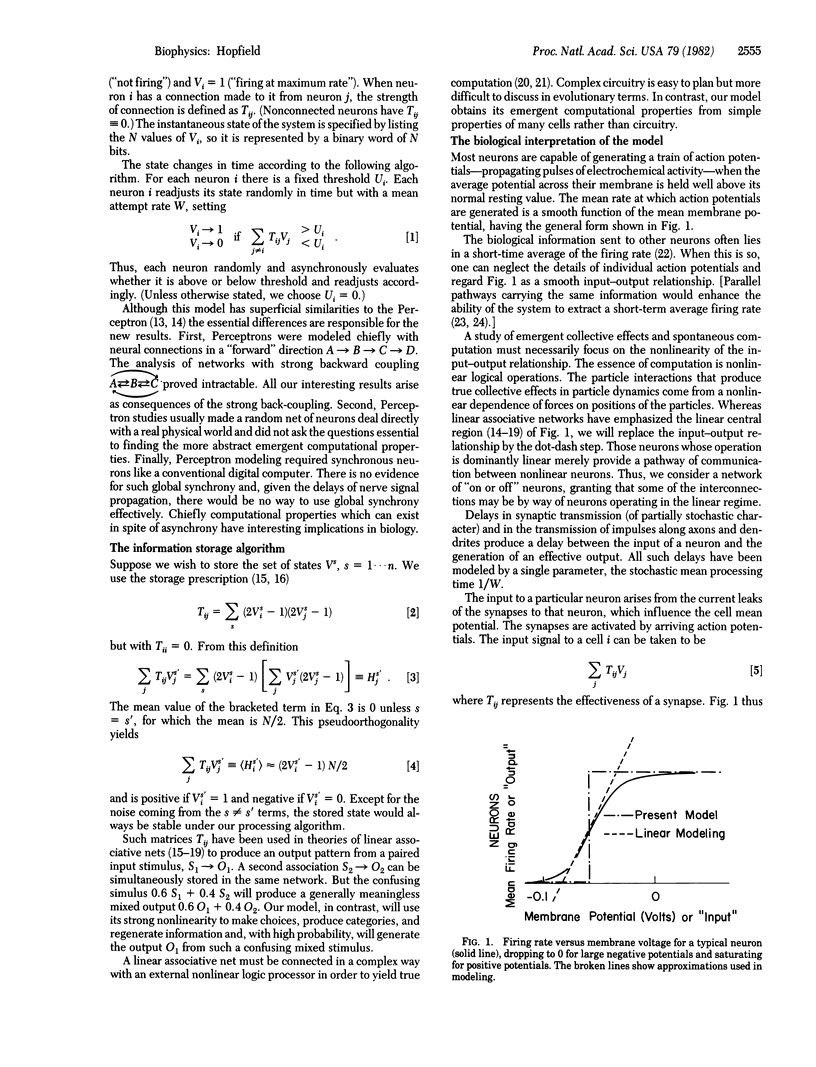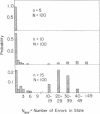Abstract
Computational properties of use of biological organisms or to the construction of computers can emerge as collective properties of systems having a large number of simple equivalent components (or neurons). The physical meaning of content-addressable memory is described by an appropriate phase space flow of the state of a system. A model of such a system is given, based on aspects of neurobiology but readily adapted to integrated circuits. The collective properties of this model produce a content-addressable memory which correctly yields an entire memory from any subpart of sufficient size. The algorithm for the time evolution of the state of the system is based on asynchronous parallel processing. Additional emergent collective properties include some capacity for generalization, familiarity recognition, categorization, error correction, and time sequence retention. The collective properties are only weakly sensitive to details of the modeling or the failure of individual devices.
Full text
PDF




Images in this article
Selected References
These references are in PubMed. This may not be the complete list of references from this article.
- Amari S. I. Neural theory of association and concept-formation. Biol Cybern. 1977 May 17;26(3):175–185. doi: 10.1007/BF00365229. [DOI] [PubMed] [Google Scholar]
- Amari S., Takeuchi A. Mathematical theory on formation of category detecting nerve cells. Biol Cybern. 1978 May 31;29(3):127–136. doi: 10.1007/BF00337348. [DOI] [PubMed] [Google Scholar]
- Cooper L. N., Liberman F., Oja E. A theory for the acquisition and loss of neuron specificity in visual cortex. Biol Cybern. 1979 Jun 29;33(1):9–28. doi: 10.1007/BF00337414. [DOI] [PubMed] [Google Scholar]
- Goldman P. S., Nauta W. J. Columnar distribution of cortico-cortical fibers in the frontal association, limbic, and motor cortex of the developing rhesus monkey. Brain Res. 1977 Feb 25;122(3):393–413. doi: 10.1016/0006-8993(77)90453-x. [DOI] [PubMed] [Google Scholar]
- John E. R. Switchboard versus statistical theories of learning and memory. Science. 1972 Sep 8;177(4052):850–864. doi: 10.1126/science.177.4052.850. [DOI] [PubMed] [Google Scholar]
- Klonguet-Higgins H. C. Holographic model of temporal recall. Nature. 1968 Jan 6;217(5123):104–104. doi: 10.1038/217104a0. [DOI] [PubMed] [Google Scholar]
- Longuet-Higgins H. C. The non-local storage of temporal information. Proc R Soc Lond B Biol Sci. 1968 Dec 31;171(1024):327–334. doi: 10.1098/rspb.1968.0074. [DOI] [PubMed] [Google Scholar]
- Marr D. A theory of cerebellar cortex. J Physiol. 1969 Jun;202(2):437–470. doi: 10.1113/jphysiol.1969.sp008820. [DOI] [PMC free article] [PubMed] [Google Scholar]
- Palm G. On associative memory. Biol Cybern. 1980;36(1):19–31. doi: 10.1007/BF00337019. [DOI] [PubMed] [Google Scholar]
- Roney K. J., Scheibel A. B., Shaw G. L. Dendritic bundles: survey of anatomical experiments and physiological theories. Brain Res. 1979;180(2):225–271. doi: 10.1016/0165-0173(79)90006-7. [DOI] [PubMed] [Google Scholar]
- Shaw S., Nelson D. L., Shearer G. M. Human cytotoxic response in vitro to trinitrophenyl-modified autologous cells. I. T cell recognition of TNP in association with widely shared antigens. J Immunol. 1978 Jul;121(1):281–289. [PubMed] [Google Scholar]
- Willows A. O., Dorsett D. A., Hoyle G. The neuronal basis of behavior in Tritonia. 3. Neuronal mechanism of a fixed action pattern. J Neurobiol. 1973;4(3):255–285. doi: 10.1002/neu.480040308. [DOI] [PubMed] [Google Scholar]
- Willwacher G. Fähigkeiten eines assoziativen Speichersystems im Vergleich zu Gehirnfunktionen. Biol Cybern. 1976 Nov 30;24(4):181–188. doi: 10.1007/BF00335979. [DOI] [PubMed] [Google Scholar]



